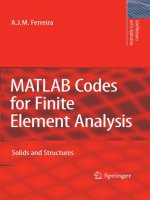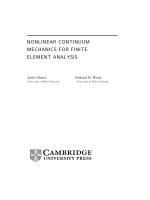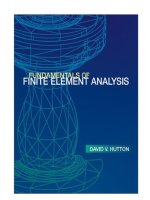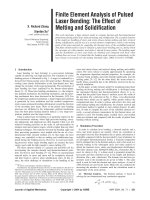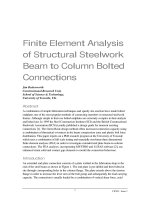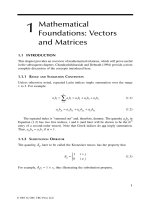Stochastic finite element analysis for free vibration of functionally graded beams
Bạn đang xem bản rút gọn của tài liệu. Xem và tải ngay bản đầy đủ của tài liệu tại đây (6.1 MB, 150 trang )
Attribution-NonCommercial-NoDerivs 2.0 KOREA
You are free to :
Share — copy and redistribute the material in any medium or format
Under the follwing terms :
Attribution — You must give appropriate credit, provide a link to the license, and
indicate if changes were made. You may do so in any reasonable manner, but
not in any way that suggests the licensor endorses you or your use.
NonCommercial — You may not use the material for commercial purposes.
NoDerivatives — If you remix, transform, or build upon the material, you may
not distribute the modified material.
You do not have to comply with the license for elements of the material in the public domain or where your use
is permitted by an applicable exception or limitation.
This is a human-readable summary of (and not a substitute for) the license.
Disclaimer
Stochastic Finite Element Analysis for
Free Vibration of Functionally Graded
Beams
Nguyen Van Thuan
August 2017
Department of Civil and Environmental Engineering
The Graduate School
Sejong University
Stochastic Finite Element Analysis for
Free Vibration of Functionally Graded
Beams
Nguyen Van Thuan
A dissertation submitted to the Faculty of the Sejong University in
partial fulfillment of the requirements for the degree of Doctor of
Philosophy in Civil and Environmental Engineering
August 2017
Approved by Major Advisor
Professor Hyuk Chun Noh
DEDICATION
I would like to dedicate this dissertation to my Parents, my Wife, and my Children
who have supported me all the way
ABSTRACT
The objective of this research is stochastic finite element method for a free
vibration characteristic of a functionally graded beam using uncertain material
properties. This study is divided into three parts.
First, we investigated the free vibration of functionally graded material (FGM)
beams on an elastic foundation and spring supports. Elastic modulus, the mass density
and the width of the beam are assumed to vary in thickness and axial directions
respectively following the exponential law. The spring supports are also taken into
account at both ends of the beam. An analytical formulation is suggested to obtain
Eigen’s solutions of the FGM beams. The numerical analyses, based on finite element
method by using a beam finite element developed in this study, are performed in order
to show the legitimacy of the analytical solutions. Some results for the natural
frequencies of the FGM beams are given considering the effect of various structural
parameters. It is also shown that the spring supports have the most effect on the
natural frequencies of FGM beams.
i
Second, we obtained the statistical dynamic of functionally graded beam with
random elastic modulus of elasticity and mass density, by using the perturbation
technique in conjunction with the finite element method. Governing equations of the
eigenvalue and eigenvector of functionally graded beam are derived from the
Hamilton's Principle. The effective material properties and cross section are assumed
to vary continuously through different directions according to the exponential law
distribution. We obtained a good agreement between the results of the first-order
perturbation technique and Monte Carlo simulation on the mean values both the
eigenvalues and the eigenvectors.
The third part deals with the stochastic analysis where both the elastic modulus
and the mass density are considered as random parameters. The correlation between
these two random parameters is considered in terms of cross-correlation function, and
the magnitude of the correlation is given in terms of the correlation coefficients. The
spectral representation method is employed to generate numerically the random fields
of the random elastic modulus and mass density. The formulation for the analysis on
the response variability of the eigen-values and vectors is presented, and the results are
compared with those of the Monte Carlo simulation. Individual two random variables
are found to affect the response variability in a different way. The material mass
density is revealed to affect the response variability more than the randomness in the
elastic modulus. From the viewpoint of the correlation between these two random
parameters, the negative correlation shows greater value of variability, and in
particular, the perfect positive correlation is found to cause not any of response
ii
variability. This feature can be foreseen if we take into account the equation of
eigenvalue for the single degree of freedom structure. In order to show the adequacy
of the proposed formulation, analyses with various parameter setups are performed
and the detailed discussion is given.
Keywords: finite element method, FGM beam, first-order perturbation technique,
spectral representation, random material property.
iii
TABLE OF CONTENTS
ABSTRACT ................................................................................................................... i
TABLE OF CONTENTS ............................................................................................ iv
LIST OF FIGURES .................................................................................................... vii
LIST OF TABLES ....................................................................................................... ix
Chapter 1 . INTRODUCTION .................................................................................... 1
1.1 Motivation ......................................................................................................... 1
1.2 The Functionally Graded Material .................................................................... 3
1.2.1 History ........................................................................................................ 3
1.2.2 The Areas of Application ............................................................................ 6
1.3 The Objectives of This Study ............................................................................ 8
1.4 The Organization of This Study ........................................................................ 9
Chapter 2 . EIGEN ANALYSIS OF THE FUNCTIONALLY GRADED BEAMS
WITH A VARIABLE CROSS-SECTION RESTING ON ELASTIC SUPPORTS
AND ELASTIC FOUNDATIONS............................................................................. 11
2.1 Introduction ..................................................................................................... 11
2.2 The Analytical Formulation ............................................................................ 13
2.2.1 FGM Beam Model.................................................................................... 13
2.2.2 The Analytical Formulation ...................................................................... 14
2.3 The Finite Element Formulation ..................................................................... 18
2.4 The Results and the Discussions ..................................................................... 22
2.5 Conclusions ..................................................................................................... 37
iv
Chapter 3 . THE EFFECT OF SINGLE UNCERTAIN MATERIAL PROPERTY
ON THE VARIABILITY OF EIGEN ANLYSIS OF FUNCTIONALLY GRADED
BEAM .......................................................................................................................... 41
3.1 Introduction .................................................................................................... 41
3.2 The Model of FGM Beam ............................................................................... 44
3.3 The Finite Element Formulation for the Deterministic Eigen Analysis .......... 46
3.3.1 The Finite Element of the Beam ............................................................... 46
3.3.2 The Strain and the Kinetic Energy of the Beam ....................................... 46
3.3.3 The Eigen Equation from the Hamilton’s Principle ................................. 47
3.4 The Stochastic Analysis of the FGM Beam Based on the Perturbation
Method .................................................................................................................. 49
3.4.1 Perturbation on the System Matrices ........................................................ 49
3.4.2 The Covariance of the Eigenvalue............................................................ 53
3.5 The Results and the Discussions ................................................................ 54
3.5.1 The Stochastic Natural Frequency ............................................................ 55
3.5.2 The Stochastic Mode Shape...................................................................... 64
3.6 Conclusions .................................................................................................... 69
Chapter 4 THE EFFECT OF MULTIPLE UNCERTAIN MATERIAL
PROPERTIES ON THE VARIABILITY OF NATURAL FREQUENCY AND
THE MODE SHAPE OF A FUNCTIONALLY GRADED BEAM ........................ 71
4.1 Introduction ..................................................................................................... 71
4.2 The Functionally Graded Material Beam ........................................................ 74
4.3 The Formulation for FGM Beam Finite Element............................................ 77
4.4 Modeling of the Randomness.......................................................................... 80
v
4.4.1 The Generation of a Random Sample....................................................... 80
4.4.2 The Monte Carlo Analysis and the Numerical Generation of the Random
Processes ........................................................................................................... 82
4.4.3 Perturbation on the System Matrices ........................................................ 86
4.5 Results and Discussions .................................................................................. 90
4.5.1 A Verified Example................................................................................... 90
4.5.2 The Effect of the Relationship between the Stochastic Characteristic of th
e Modulus and the Mass Density....................................................................... 93
4.6 Conclusions ................................................................................................... 111
Chapter 5 . CONCLUSIONS AND FUTURE WORK .......................................... 113
5.1 Conclusions ................................................................................................... 113
5.2 Future Work .................................................................................................. 116
References ................................................................................................................. 121
국문초록 .................................................................................................................... 130
Acknowledgements ................................................................................................... 133
vi
LIST OF FIGURES
Fig.
1.1.
Schematic
of
continuously
graded
microstructure
with
metal-
ceramic constituents. ...................................................................................................... 4
Fig. 1.2. Gradation in a cross-section of a animal bone. ................................................ 5
Fig. 1.3. Microstructure of functionally graded bamboo fiber ....................................... 5
Fig. 1.4. Some example of FGMs in engineered by humans.......................................... 7
Fig. 1.5. Contents of thesis ........................................................................................... 10
Fig. 2.1. Model of FGM beam...................................................................................... 14
Fig. 2.2. Beam finite element ....................................................................................... 18
Fig. 2.3. Dimensionless natural frequencies of FGM beams ( E1 / E0 = 1.0) ................ 28
Fig. 2.4. Dimensionless natural frequencies of FGM beams ( E1 / E0 = 5.0) ............... 29
Fig. 2.5. Natural frequencies with RK f = 1.0 ................................................................. 31
Fig. 2.6. Error depending on mesh refinement E1 /E0 =1.0, RK = RK = 1.0 ............... 33
1
2
Fig. 2.7. Error depending on mesh refinement E1 /E0 =5.0, RK = RK = 1.0 ............... 34
1
2
Fig. 2.8. Normalized mode shapes of the FGM beam when E1 / E0 = 2.0, y =1.0 ......... 36
Fig. 3.1. Model of FGM beams .................................................................................... 44
Fig. 3.2. FGM beam model .......................................................................................... 54
Fig. 3.3. COV of natural frequency as a function of the correlation distance d for differ
ent standard deviation s ff of the stochastic process.................................................. 57
Fig. 3.4. COV of natural frequency as a function of .................................................... 58
Fig. 3.5. Effect of mesh refinement on the COV of natural frequency (s ff = 0.1). ...... 60
Fig. 3.6. Effect of non-uniformity parameter (y ) on COV of natural frequency. ..... 61
Fig. 3.7. Effect of parameter b of the COV natural frequency ( Ne = 20, s ff = 0.1).
...................................................................................................................................... 62
Fig. 3.8. The mean of mode shapes .............................................................................. 65
vii
Fig. 3.9. SD of mode shapes ......................................................................................... 66
Fig. 3.10. Effect of non-uniformity parameter (y ) on the response variability of SD
...................................................................................................................................... 67
Fig. 3.11. Effect of parameter ( b ) on the response variability of SD ....................... 68
Fig. 4.1. Functionally graded beam .............................................................................. 74
Fig. 4.2. The variation of elasticity modulus, mass density and width along the corresp
onding directions .......................................................................................................... 76
Fig. 4.3. Beam finite element ....................................................................................... 77
Fig. 4.4. Conceptual description of Gaussian distribution ........................................... 81
Fig. 4.5. Example plot of random processes (d = 0.01, 0.1, 1.0, s ff = 0.1) ................. 85
Fig. 4.6. COV of eigenvalue......................................................................................... 91
Fig. 4.7. The effect of relationship between stochastic characteristic of elastic modulus
and mass density on response COV of the eigenvalue. .............................................. 92
Fig. 4.8. Effect of the correlation between two random parameters. ........................... 96
Fig. 4.9. COV of natural frequency as a function of the standard deviation of stochasti
c process for the multiple random parameters. ............................................................. 97
Fig. 4.10. Effect of mesh refinement on the COV of natural frequency (s ff = 0.1). . 99
Fig. 4.11. Effect of non-uniformity parameter on the COV of natural frequency ...... 100
Fig. 4.12. Effect of parameter on the COV of natural frequency (s ff = 0.1). ............ 102
Fig. 4.13. SD of mode shape 1 ( Ne = 20, s ff = 0.1). .................................................. 104
Fig. 4.14. SD of mode shape 2 ( Ne = 20, s ff = 0.1). .................................................. 105
Fig. 4.15. SD of mode shape 3 ( Ne = 20, s ff = 0.1). .................................................. 106
Fig. 4.16. Effect of non-uniformity parameter (y ) on SD in mode 1 ......................... 108
Fig. 4.17. Effect of non-uniformity parameter (y ) on SD in mode 2 ......................... 109
Fig. 4.18. Effect of non-uniformity parameter (y ) on SD in mode 3 ......................... 110
viii
LIST OF TABLES
Table 2.1. First three dimensionless natural frequencies v of a uniform FGM beam
(y = 0, RK f = 0, RKi = 0). ................................................................................................. 23
Table 2.2. First three dimensionless natural frequencies of non-uniform FGM beams.
...................................................................................................................................... 23
Table 3.1. Comparison of SFEM with MCS results. .................................................... 55
Table 4.1. Ensemble statistics on the numerically generated random samples ............ 84
ix
Chapter 1 . INTRODUCTION
1.1 Motivation
Functionally graded material (FGM) is an excellent advanced material that
revolutionize the manufacturing world in the 21st century. The advantages of using
FGM is to include potential reduction of in-plane and through the thickness transverse
stress, the improved thermal properties, and the high toughness. FGMs that consist of
metallic and ceramic components are well known to enhance the properties of
thermal-barrier systems because cracking or de-lamination, which are often observed
in conventional multi-layer systems are avoided due to the smooth transition between
the properties of the components. By varying percentage contents of volume fractions
of two or more materials spatially, FGMs can be formed that will have the desired
property gradation in spatial directions. Delamination has been a problem of main
concern in the reliable design of advanced fiber reinforced composite laminates. In
laminated composites, the separation of layers caused by high local inter-laminar
stresses result in destruction of load transfer mechanism, the reduction of stiffness and
the loss of structural integrity, which leads to the final structural and functional failure.
To eliminate these problems, FGMs have now gained importance, and are the latest
advanced materials, that have been discovered by material scientists for innovative
engineering applications (Jha et al. 2013). However, the manufacturing and processing
1
of FGM’s, with fully specified profile of material gradation, may result in significant
variability in their mechanical and structural properties.
These variables are statistical in nature and are reflected in the scattering of the
material properties, the structural stiffness and micro-mechanical behavior, and may
affect the fundamental characteristics of the structural response such as the frequency
response. Therefore, the appropriately handling of the randomness of the material
properties is required for an accurate prediction of the structural response for safe and
reliable design. The stochastic analysis is a useful analytical tool to be able to predict
accurately the response of structures with random material properties by the theory of
random fields.
In most of the studies conducted, researchers dealt with the free vibration of
functionally graded structures with uncertain material property using first order
perturbation technique (FOPT) to resolve the standard eigenvalue problem (Jagtap et
al. 2001, Kar et al. 2017, Kitipornchai et al. 2006, Shaker et al. 2008, Shegokar et al.
2016). The studies on the eigenvalue and eigenvector in beams with uncertain material
properties are very limited in the literature, so further studies are necessary.
2
1.2 The Functionally Graded Material
1.2.1 History
Many new materials have been developed in recent years, including the
functionally graded materials. In 1984, the theory of the functionally graded materials
was first introduced in Japan during the space plane project (Koizumi 1997). Generally,
the FGM is a material in which the volume fractions of two or more material
components are created to vary continuously with position in Figure 1.1 (Shahistha et
al. 2014). In particular, it varies continuously along the thickness direction.
Although the concept of FGM and ability to fabricate them appears to be an
advanced engineering invention but the concept is not new (Kar et al. 2017). These
sorts of materials may occur in nature, which is shown in Figure 1.3. Bones have
functional grading. Our skin is also graded in order to provide certain toughness, as
well as tactile and elastic qualities as a function of skin depth and location on the body.
This is shown in Figure 1.2.
3
Enlarged View Ceramic-Metal FGM
Smoothly Graded Microstructure
Fig. 1.1. Schematic of continuously graded microstructure with metal-ceramic
constituents.
4
Fig. 1.2. Gradation in a cross-section of a animal bone.
Fig. 1.3. Microstructure of functionally graded bamboo fiber
5
1.2.2 The Areas of Application
The application of the advanced materials was first visualized, during a space
panels project in 1984 in National Laboratory of Japan, to avoid the stress peaks at
interfaces in coated panels for the space shuttle. The concept of the FGM was
successfully applied in the thermal barrier coatings where the environmental
requirements are to improve resistance to high temperature, oxidation and corrosion.
Up to now, the FGM has also been applied to a variety of engineering fields
(Rasheedat et al. 2012, Shahistha et al. 2014, Gururaja et al. 2014, Kumar et al. 2016
and Kar et al. 2017). With the continuous expanding of the FGM research, it was
discovered that the composition, structure and properties of gradient changes can be
adjusted more effectively for particular application (Figure 1.4).
The use of FGM’s extended to commercial and industrial applications such as with
automobiles: combustion chambers, engine cylinder liners, CNG storage cylinders,
diesel engine pistons, brake rotors, leaf springs, drive shafts, flywheels. FGM was
originally advanced as an aerospace application in order to sustain height thermal
barrier coatings such as rocket nozzle, heat exchanger panels, engine parts, wind
tunnel blades, and spacecraft truss structure. The defense application, such as special
purpose armor developments for naval application the focus on submarine equipment
including propulsion shaft, cylindrical pressure hull, sonar domes, and composite ping
system. FGM has a wide range of biomedical application in dental and orthopedic
implants for teeth and bone replacement, and it is expected to be applied to many other
fields.
6
(a) Thermal coating
(b) Rocket casing
(c) Ceramic-metal FGM
Fig. 1.4. Some example of FGMs in engineered by humans.
7
1.3 The Objectives of This Study
The objective of this study is to obtain stochastic eigenvalue and eigenvector of
FGM beams on random material properties. Three major objectives are detailed, as
follows:
Objective I: The dynamic behavior of FGM beams on elastic foundation. In
particular, additional effects of varying sectional properties, elastic end-springs and
elastic foundation on the dynamic characteristics of FGM beams are explained by
using the formulation suggested in this study.
Objective II: The eigenvalue and eigenvector analysis of FGM beam using first
order perturbation technique (FOPT) and Monte Carlo simulation base on stochastic
finite element method are shown. During stochastic analysis of MCS, the natural
frequencies and mode shape of FGM beam are obtained from the random processes
generation technique of spectral representation.
Objective III: A FGM beam finite element for beam structures made of FGM
with varying width is developed and employed in the stochastic finite element analysis
to obtain the response variability in the natural frequency and mode shape of FGM
beam using first-order perturbation technique and MCS. Not only the sole effect of the
single random elastic modulus or mass density but also the effect of multiple uncertain
material properties on the response variability of natural frequency and mode shape is
studied. For MCS, the random processes for the random elastic modulus and mass
density are generated by using the spectral representation method.
8
1.4 The Organization of This Study
This thesis includes five chapters covering four subjects of this study. The
structure of thesis is shown in Figure 1.5. Each chapter is described in details below.
Chapter I. Introduction
This chapter presents motivation, FGM, goal and objective of this dissertation.
Chapter II. Eigen analysis of the functionally graded beams with variable crosssection resting on elastic supports and elastic.
An analytical formulation is suggested to obtain eigen solutions of the FGM beams.
Numerical analyses, based on finite element method by using a beam finite element
developed in this study, are performed in order to show the legitimacy of the analytical
solutions.
Chapter III. The effect of single uncertain material property on the variability of
eigen anlysis of functionally graded beam.
The eigenvalue and eigenvector variability of FGM beams with single uncertain
material parameter, i.e., elastic modulus and mass density are shown. The results are
performed in conjunction with Monte Carlo simulation.
9
Chapter IV. The effect of multiple uncertain material properties on the variability of
eigen analysis of functionally graded beam.
A formulation is suggested in order to determine the eigenvalue and eigenvector
variability of FGM beams with multiple uncertain material parameters, i.e., elastic
modulus and mass density.
Chapter V. Conclusions and future works.
Stochastic finite element analysis for free vibration characteristics of
functionally graded beams
Chapter 1: Introduction
Deterministic analysis
Probabilistic analysis
Chapter 2: Eigen analysis of the functionally graded beams with
variable cross-section resting on elastic supports and elastic foundation.
Chapter 3: The effect of single uncertain material property on the
variability of eigen analysis of functionally graded beam.
Chapter 4: The effect of multiple uncertain material properties on the
variability of eigen analysis of functionally graded beam.
Chapter 5: Conclusions and future works
Fig. 1.5. Contents of thesis
10
